Thin Film Deposition by Atmospheric Pressure Dielectric Barrier Discharges Containing Eugenol: Discharge and Coating Characterizations
Abstract
1. Introduction
2. Materials and Methods
3. Results and Discussion
3.1. Electric Characteristics
3.1.1. Voltage and Current Waveforms
3.1.2. Lissajous Figures and Plasma Power
3.2. Optical Emission Spectroscopy of the Discharges
3.2.1. Effect of Discharge Parameters on Plasma Composition
3.2.2. Effect of Discharge Parameters on Electron Temperature
3.3. Thickness and Roughness of the Film
3.4. Molecular Structure
3.5. Stability and Aging
4. Conclusions
Author Contributions
Funding
Conflicts of Interest
References
- Khoja, A.H.; Tahir, M.; Amin, N.A.S. Recent developments in non-thermal catalytic DBD plasma reactor for dry reforming of methane. Energy Convers. Manag. 2019, 183, 529–560. [Google Scholar] [CrossRef]
- Laroussi, M.; Lu, X.; Keidar, M. Perspective: The physics, diagnostics, and applications of atmospheric pressure low-temperature plasma sources used in plasma medicine. J. Appl. Phys. 2017, 122, 020901. [Google Scholar] [CrossRef]
- Şahin, N.; Tanışlı, M. Electron temperature estimation of helium plasma via line intensity ratio at atmospheric pressure. Eur. Phys. J. Plus 2020, 135, 653. [Google Scholar] [CrossRef]
- Panta, G.P.; Baniya, H.B.; Dhungana, S.; Subedi, D.P.; Papadaki, A.P. Ozonizer Design by Using Double Dielectric Barrier Discharge for Ozone Generation. Afr. Rev. Phys. 2020, 15, 43–55. [Google Scholar]
- Panta, G.P.; Subedi, D.P.; Baniya, H.B.; Papadaki, A.P.; Dhungana, S. An Experimental Study of Co-Axial Dielectric Barrier Discharge for Ozone Generation. J. Nepal Phys. Soc. 2020, 6, 2738–9537. [Google Scholar] [CrossRef]
- Cvrček, L.; Horáková, M. Plasma Modified Polymeric Materials for Implant Applications. In Non-Thermal Plasma Technology for Polymeric Materials; Elsevier: Amsterdam, The Netherlands, 2019; pp. 367–407. [Google Scholar]
- Kim, S.J.; Chung, T.H. Cold atmospheric plasma jet-generated RONS and their selective effects on normal and carcinoma cells. Sci. Rep. 2016, 6, 20332. [Google Scholar] [CrossRef]
- Iseki, S.; Nakamura, K.; Hayashi, M.; Tanaka, H.; Kondo, H.; Kajiyama, H.; Kano, H.; Kikkawa, F.; Hori, M. Selective killing of ovarian cancer cells through induction of apoptosis by nonequilibrium atmospheric pressure plasma. Appl. Phys. Lett. 2012, 100, 113702. [Google Scholar] [CrossRef]
- Tsai, T.-C.; Mcintyre, K.; Burnette, M.; Staack, D. Copper film deposition using a helium dielectric barrier discharge jet. Plasma Process. Polym. 2020. [Google Scholar] [CrossRef]
- Kaushik, N.K.; Kaushik, N.; Linh, N.N.; Ghimire, B.; Pengkit, A.; Sornsakdanuphap, J.; Lee, S.J.; Choi, E.H. Plasma and nanomaterials: Fabrication and biomedical applications. Nanomaterials 2019, 9, 98. [Google Scholar] [CrossRef]
- Misra, N.N.; Yadav, B.; Roopesh, M.S.; Jo, C. Cold Plasma for Effective Fungal and Mycotoxin Control in Foods: Mechanisms, Inactivation Effects, and Applications. Compr. Rev. Food Sci. Food Saf. 2019, 18, 106–120. [Google Scholar] [CrossRef]
- Cha, S.; Park, Y.S. Plasma in dentistry. Clin. Plasma Med. 2014, 2, 4–10. [Google Scholar] [CrossRef] [PubMed]
- Kalghatgi, S.; Kelly, C.M.; Cerchar, E.; Torabi, B.; Alekseev, O.; Fridman, A.; Friedman, G.; Azizkhan-Clifford, J. Effects of non-thermal plasma on mammalian cells. PLoS ONE 2011, 6, e16270. [Google Scholar] [CrossRef] [PubMed]
- Haertel, B.; von Woedtke, T.; Weltmann, K.D.; Lindequist, U. Non-thermal atmospheric-pressure plasma possible application in wound healing. Biomol. Ther. 2014, 22, 477–490. [Google Scholar] [CrossRef] [PubMed]
- Justan, I.; Cernohorska, L.; Dvorak, Z.; Slavicek, P. Plasma discharge, and time-dependence of its effect on bacteria. Folia Microbiol. 2014, 59, 315–320. [Google Scholar] [CrossRef] [PubMed]
- Irani, S.; Shahmirani, Z.; Atyabi, S.M.; Mirpoor, S. Induction of growth arrest in colorectal cancer cells by cold plasma and gold nanoparticles. Arch. Med. Sci. 2015, 11, 1286–1295. [Google Scholar] [CrossRef]
- Sakudo, A.; Yagyu, Y.; Onodera, T. Disinfection and sterilization using plasma technology: Fundamentals and future perspectives for biological applications. Int. J. Mol. Sci. 2019, 20, 5216. [Google Scholar] [CrossRef]
- Bernhardt, T.; Semmler, M.L.; Schäfer, M.; Bekeschus, S.; Emmert, S.; Boeckmann, L. Plasma Medicine: Applications of Cold Atmospheric Pressure Plasma in Dermatology. Oxid. Med. Cell. Longev. 2019, 2019, 10–13. [Google Scholar] [CrossRef]
- Martines, E. Special issue “plasma technology for biomedical applications”. Appl. Sci. 2020, 10, 1524. [Google Scholar] [CrossRef]
- Khan, T.M.; Khan, S.U.D.; Khan, S.U.D.; Ahmad, A.; Abbasi, S.A. A new strategy of using dielectric barrier discharge plasma in tubular geometry for surface coating and extension to biomedical application. Rev. Sci. Instrum. 2020, 91, 073902. [Google Scholar] [CrossRef]
- Rahman, M.J.; Bhuiyan, A.H. Structural and optical properties of plasma polymerized o-methoxyaniline thin films. Thin Solid Films 2013, 534, 132–136. [Google Scholar] [CrossRef]
- Bazaka, K.; Jacob, M.V.; Truong, V.K.; Wang, F.; Pushpamali, W.A.A.; Wang, J.Y.; Ellis, A.V.; Berndt, C.C.; Crawford, R.J.; Ivanova, E.P. Plasma-enhanced synthesis of bioactive polymeric coatings from monoterpene alcohols: A combined experimental and theoretical study. Biomacromolecules 2010, 11, 2016–2026. [Google Scholar] [CrossRef] [PubMed]
- Jacob, M.V.; Bazaka, K.; Taguchi, D.; Manaka, T.; Iwamoto, M. Electron-blocking hole-transport polyterpenol thin films. Chem. Phys. Lett. 2012, 528, 26–28. [Google Scholar] [CrossRef]
- Ahmad, J.; Bazaka, K.; Jacob, M. Optical and Surface Characterization of Radio Frequency Plasma Polymerized 1-Isopropyl-4-Methyl-1,4-Cyclohexadiene Thin Films. Electronics 2014, 3, 266–281. [Google Scholar] [CrossRef]
- Easton, C.D.; Jacob, M.V. Optical characterization of radiofrequency plasma polymerized Lavandula angustifolia essential oil thin films. Thin Solid Films 2009, 517, 4402–4407. [Google Scholar] [CrossRef]
- Anderson, L.J.; Jacob, M.V.; Barra, M.; Di Girolamo, F.V.; Cassinese, A. Effect of plasma polymerized linalyl acetate dielectric on the optical and morphological properties of an n-type organic semiconductor. Appl. Phys. A Mater. Sci. Process. 2011, 105, 95–102. [Google Scholar] [CrossRef][Green Version]
- Ostrikov, K. Reactive plasmas as a versatile nanofabrication tool. Rev. Mod. Phys. 2005, 77, 489–511. [Google Scholar] [CrossRef]
- Bazaka, K.; Jacob, M.V.; Bowden, B.F. Optical and chemical properties of polyterpenol thin films deposited via plasma-enhanced chemical vapor deposition. J. Mater. Res. 2011, 26, 1018–1025. [Google Scholar] [CrossRef]
- Adil, B.H.; Al-Shammari, A.M.; Murbat, H.H. Breast cancer treatment using cold atmospheric plasma generated by the FE-DBD scheme. Clin. Plasma Med. 2020, 19–20, 100103. [Google Scholar] [CrossRef]
- Sato, M.; Aono, H.; Yakeno, A.; Nonomura, T.; Fujii, K.; Okada, K.; Asada, K. Multifactorial effects of operating conditions of dielectric-barrier-discharge plasma actuator on laminar-separated-flow control. AIAA J. 2015, 53, 2544–2559. [Google Scholar] [CrossRef]
- Peeters, F.J.J.; Yang, R.; Van De Sanden, M.C.M. The relation between the production efficiency of nitrogen atoms and the electrical characteristics of a dielectric barrier discharge. Plasma Sources Sci. Technol. 2015, 24. [Google Scholar] [CrossRef]
- Sewraj, N.; Merbahi, N.; Gardou, J.P.; Akerreta, P.R.; Marchal, F. Electric and spectroscopic analysis of a pure nitrogen mono-filamentary dielectric barrier discharge (MF-DBD) at 760 Torr. J. Phys. D 2011, 44, 145201. [Google Scholar] [CrossRef]
- Nastuta, A.V.; Pohoata, V.; Mihaila, I.; Topala, I. Diagnosis of a short-pulse dielectric barrier discharge at atmospheric pressure in helium with hydrogen-methane admixtures. Phys. Plasmas 2018, 25, 043515. [Google Scholar] [CrossRef]
- Stanfield, S.A.; Menart, J.A. Spectroscopic investigation of a dielectric barrier discharge. AIAA J. 2014, 52, 991–997. [Google Scholar] [CrossRef]
- Tschiersch, R.; Bogaczyk, M.; Wagner, H.E. Systematic investigation of the barrier discharge operation in helium, nitrogen, and mixtures: Discharge development, formation, and decay of surface charges. J. Phys. D 2014, 47, 365204. [Google Scholar] [CrossRef]
- Getnet, T.G.; Silva, G.F.; Duarte, I.S.; Kayama, M.E.; Rangel, E.C.; Cruz, N.C. Atmospheric Pressure Plasma Chemical Vapor Deposition of Carvacrol Thin Films on Stainless Steel to Reduce the Formation of E. Coli and S. Aureus Biofilms. Materials 2020, 13, 3166. [Google Scholar] [CrossRef]
- Getnet, T.G.; da Cruz, N.C.; Kayama, M.E.; Rangel, E.C. Plasma polymer deposition of neutral agent carvacrol on a metallic surface by using dielectric barrier discharge plasma in ambient air. In International Conference on Advances of Science and Technology; Springer International Publishing: Berlin, Germany, 2020; Volume 308, pp. 716–725. [Google Scholar]
- Jin, Y.; Ren, C.; Yang, L.; Zhang, J.; Wang, D. Atmospheric pressure plasma jet in ar and O2/Ar mixtures: Properties and high performance for surface cleaning. Plasma Sci. Technol. 2013, 15, 1203–1208. [Google Scholar] [CrossRef][Green Version]
- Xiao, D.; Cheng, C.; Shen, J.; Lan, Y.; Xie, H.; Shu, X.; Meng, Y.; Li, J.; Chu, P.K. Characteristics of atmospheric-pressure non-thermal N2 and N2/O2 gas mixture plasma jet. J. Appl. Phys. 2014, 115, 033303. [Google Scholar] [CrossRef]
- Ni, T.L.; Ding, F.; Zhu, X.D.; Wen, X.H.; Zhou, H.Y. Cold microplasma plume produced by a compact and flexible generator at atmospheric pressure. Appl. Phys. Lett. 2008, 92, 241503. [Google Scholar] [CrossRef]
- Kayama, M.E.; Da Silva, L.J.; Prysiazhnyi, V.; Kostov, K.G.; Algatti, M.A. Characteristics of needle-disk electrodes atmospheric pressure discharges applied to modify PET wettability. IEEE Trans. Plasma Sci. 2017, 45, 843–848. [Google Scholar] [CrossRef]
- Yokoyama, T.; Kogoma, M.; Moriwaki, T.; Okazaki, S. The mechanism of the stabilization of glow plasma at atmospheric pressure. J. Phys. D 1990, 23, 1125. [Google Scholar] [CrossRef]
- Gulati, P.; Pal, U.; Kumar, M.; Prakash, R.; Srivastava, V.; Vyas, V. Diagnostic of plasma discharge parameters in helium-filled dielectric barrier discharge. J. Theor. Appl. Phys. 2012, 6, 35. [Google Scholar] [CrossRef]
- Liu, Y.; Starostin, S.A.; Peeters, F.J.J.; Van De Sanden, M.C.M.; De Vries, H.W. Atmospheric-pressure diffuse dielectric barrier discharges in Ar/O2 gas mixture using 200 kHz/13.56 MHz dual-frequency excitation. J. Phys. D Appl. Phys. 2018, 51, 114002. [Google Scholar] [CrossRef]
- Hao, Z.; Ji, S.; Zhong, L.; Ren, W. Optical and electric diagnostics of DBD plasma jet in atmospheric pressure Argon. In Proceedings of the 2012 IEEE International Conference on Condition Monitoring and Diagnosis, CMD 2012, Bali, Indonesia, 23–27 September 2012; pp. 1187–1190. [Google Scholar]
- Jun-Feng, Z.; Xin-Chao, B.; Qiang, C.; Fu-Ping, L.; Zhong-Wei, L. Diagnosis of Methane Plasma Generated in an Atmospheric Pressure DBD Micro-Jet by Optical Emission Spectroscopy. Chin. Phys. Lett. 2009, 26, 035203. [Google Scholar] [CrossRef]
- Falahat, A.; Ganjovi, A.; Taraz, M.; Ravari, M.N.R.; Shahedi, A. Optical characteristics of an RF DBD plasma jet in various Ar/O2 mixtures. Pramana-J. Phys. 2018, 90, 27. [Google Scholar] [CrossRef]
- Shrestha, R.; Subedi, D.P.; Tyata, R.B.; Wong, C.S. Generation and diagnostics of atmospheric pressure dielectric barrier discharge in argon/air. Indian J. Pure Appl. Phys. 2017, 55, 155–162. [Google Scholar]
- Mazhir, S.N.; Khalaf, M.K.; Taha, S.K.; Mohsin, H.K. Measurement of plasma electron temperature and density by using different applied voltages and working pressures in a magnetron sputtering system. Int. J. Eng. Technol. 2018, 7, 1177–1180. [Google Scholar] [CrossRef][Green Version]
- Mertens, J.; Baneton, J.; Ozkan, A.; Pospisilova, E.; Nysten, B.; Delcorte, A.; Reniers, F. Atmospheric pressure plasma polymerization of organics: Effect of the presence and position of double bonds on polymerization mechanisms, plasma stability, and coating chemistry. Thin Solid Films 2019, 671, 64–76. [Google Scholar] [CrossRef]
- Raizer, Y.P.; Allen, J.E. Gas Discharge Physics; Springer: New York, NY, USA, 1991; p. 19. [Google Scholar]
- Chiper, A.S.; Chen, W.; Stamate, E. Diagnostics of DBD Plasma Produced Inside a Closed Package. In Proceedings of the ISPC_19, Bochum, Germany, 26–31 July 2009; pp. 26–31. [Google Scholar]
- Arefi-Khonsari, F.; Tatoulian, M. Plasma Processing of Polymers by a Low-Frequency Discharge with Asymmetrical Configuration of Electrodes. In Advanced Plasma Technology; d’Agostino, R., Favia, P., Kawai, Y., Ikegami, H., Sato, N., Arefi-Khonsari, F., Eds.; Wiley Press Room: Washington, DC, USA, 2008; Volume 8, pp. 137–174. [Google Scholar]
- Santos, N.M.; Gonçalves, T.M.; de Amorim, J.; Freire, C.M.A.; Bortoleto, J.R.R.; Durrant, S.F.; Ribeiro, R.P.; Cruz, N.C.; Rangel, E.C. Effect of the plasma excitation power on the properties of SiOxCyHz films deposited on AISI 304 steel. Surf. Coat. Technol. 2017, 311, 127–137. [Google Scholar] [CrossRef]
- Roy, N.; Talukder, M. Electrical and Spectroscopic Diagnostics of Atmospheric Pressure DBD Plasma Jet. J. Bangladesh Acad. Sci. 2016, 40, 23–36. [Google Scholar] [CrossRef]
- Matin, R.; Bhuiyan, A.H. Infrared and ultraviolet-visible spectroscopic analyses of plasma polymerized 2,6 diethylaniline thin films. Thin Solid Films 2013, 534, 100–106. [Google Scholar] [CrossRef]
- Jacob, M.V.; Easton, C.D.; Anderson, L.J.; Bazaka, K. RF plasma polymerized thin films from natural resources. Int. J. Mod. Phys. Conf. Ser. 2014, 32, 1460319. [Google Scholar] [CrossRef]
- Aziz, G.; Thukkaram, M.; De Geyter, N.; Morent, R. Plasma parameters effects on the properties, aging, and stability behaviors of allylamine plasma coated ultra-high molecular weight polyethylene (UHMWPE) films. Appl. Surf. Sci. 2017, 409, 381–395. [Google Scholar] [CrossRef]
- Chan, Y.W.; Siow, K.S.; Ng, P.Y.; Gires, U.; Yeop Majlis, B. Plasma polymerized carvone as an antibacterial and biocompatible coating. Mater. Sci. Eng. C 2016, 68, 861–871. [Google Scholar] [CrossRef]
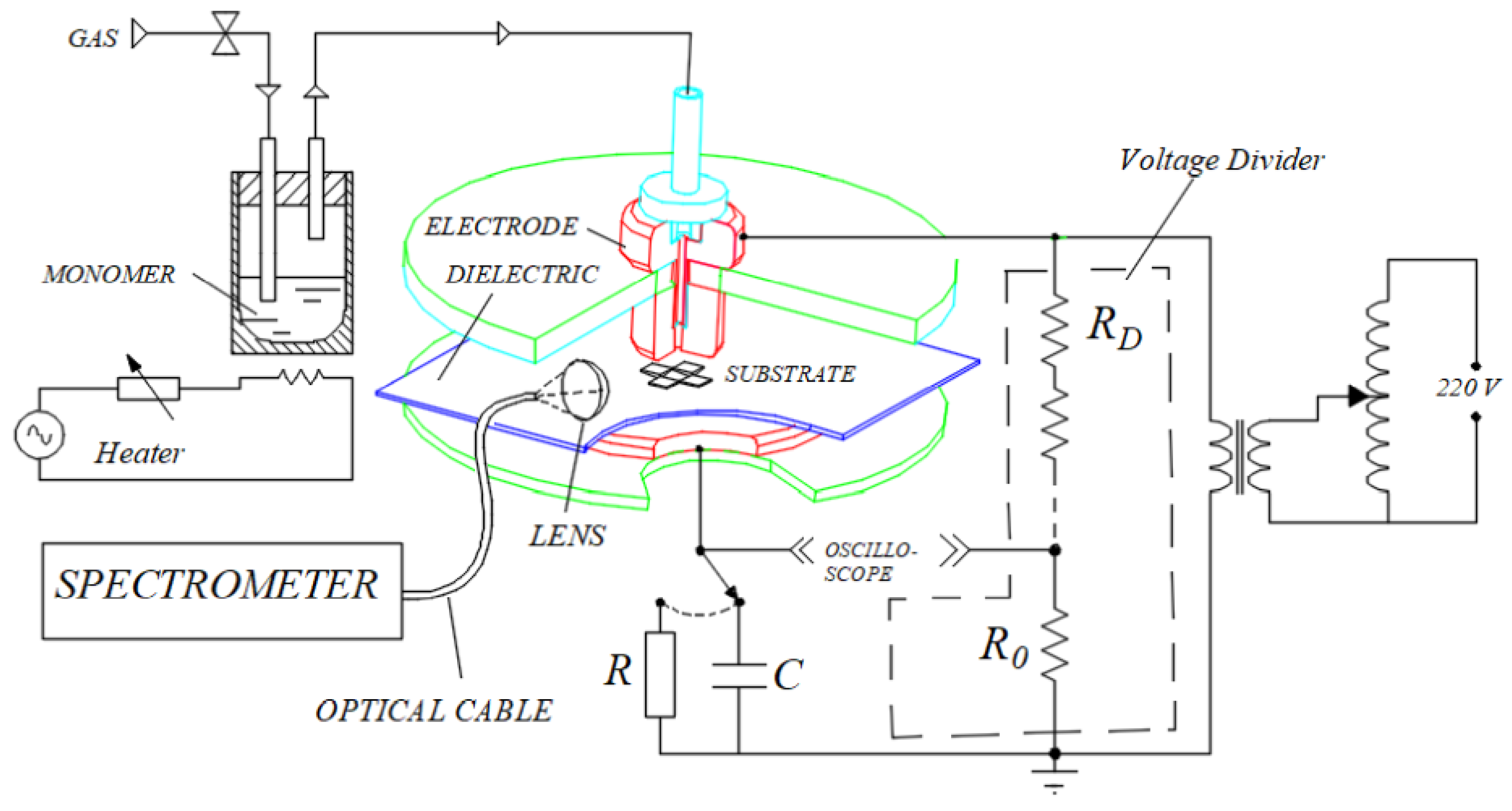
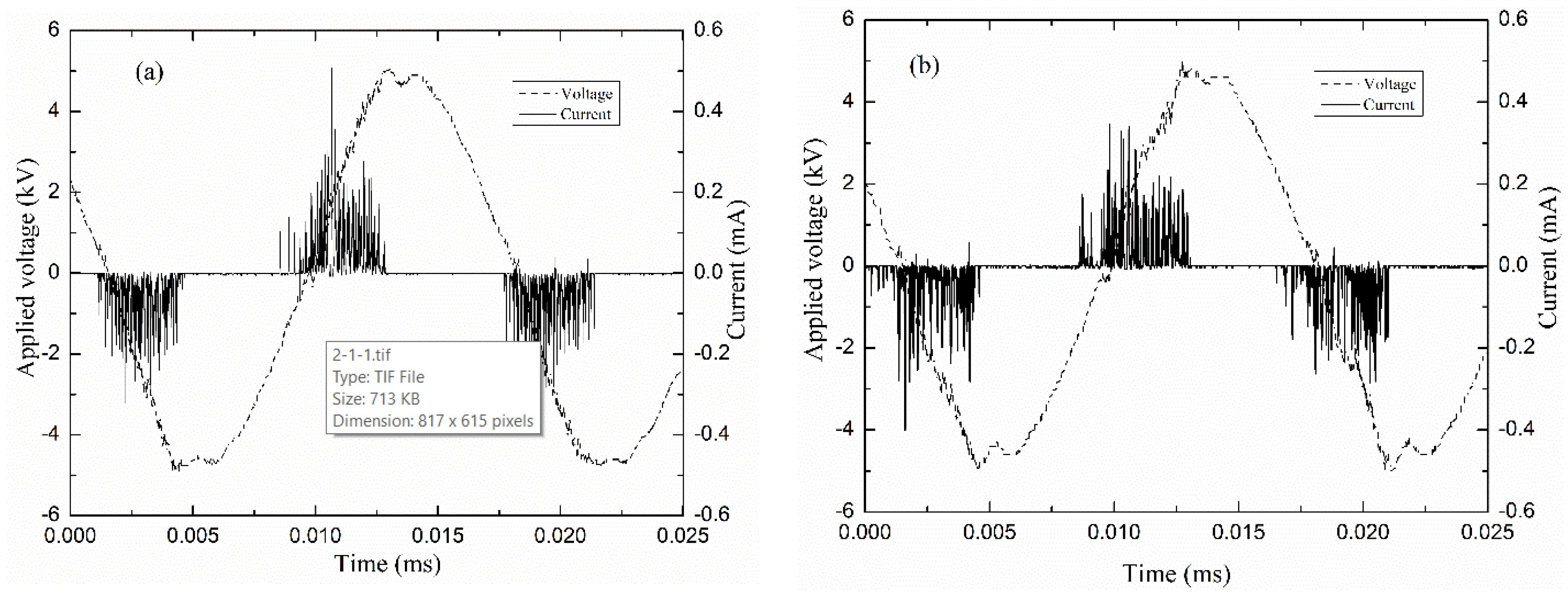


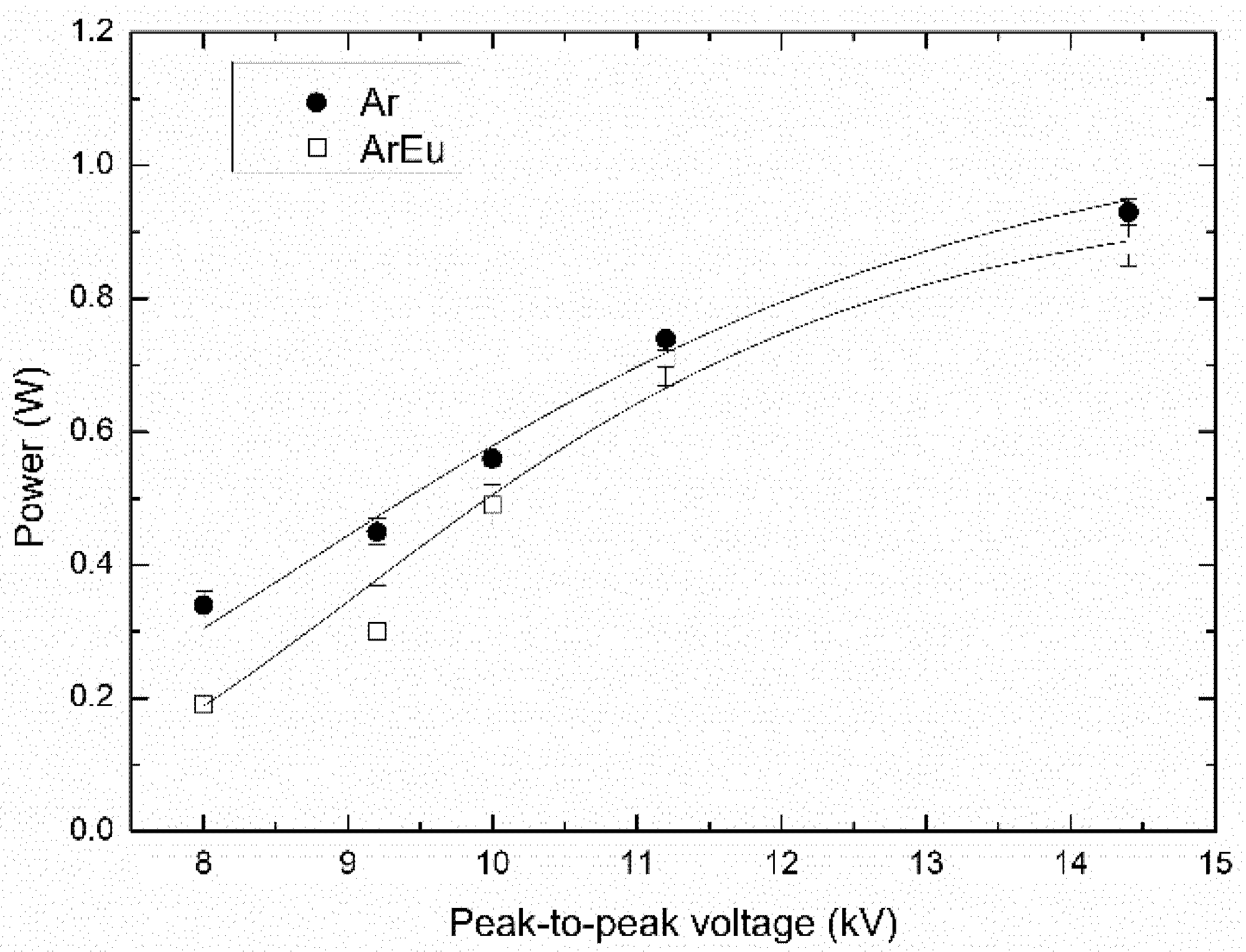

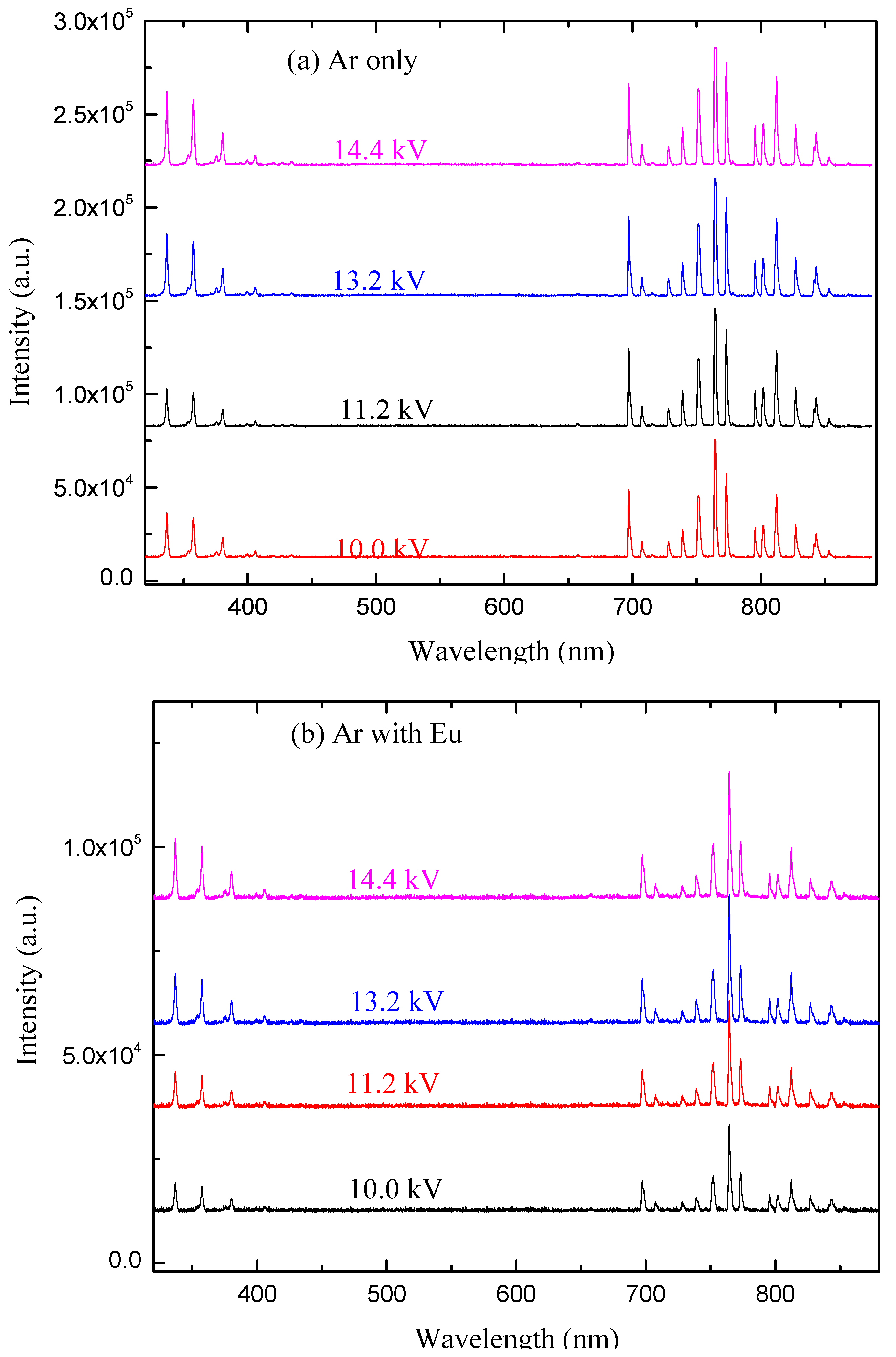
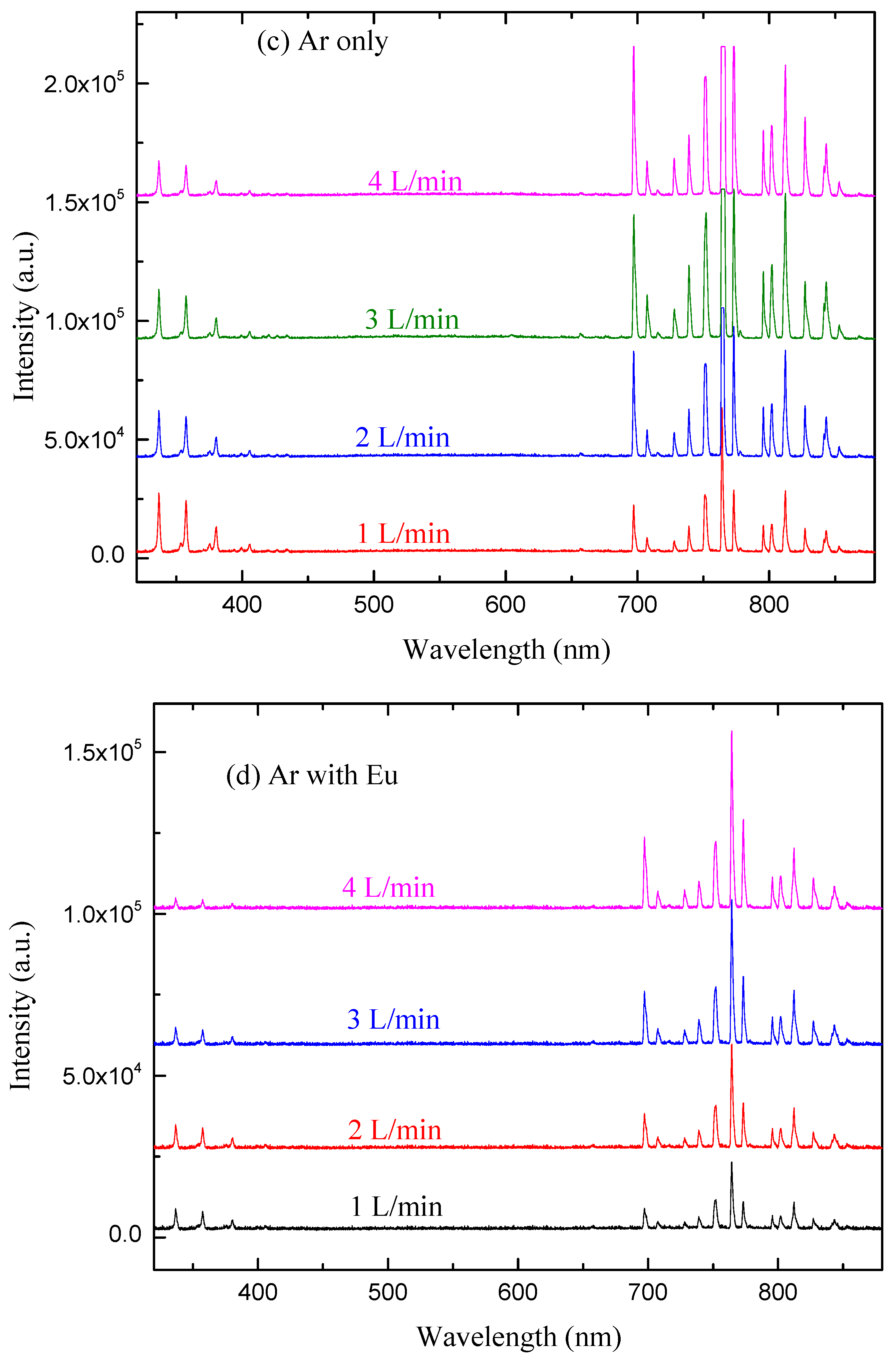
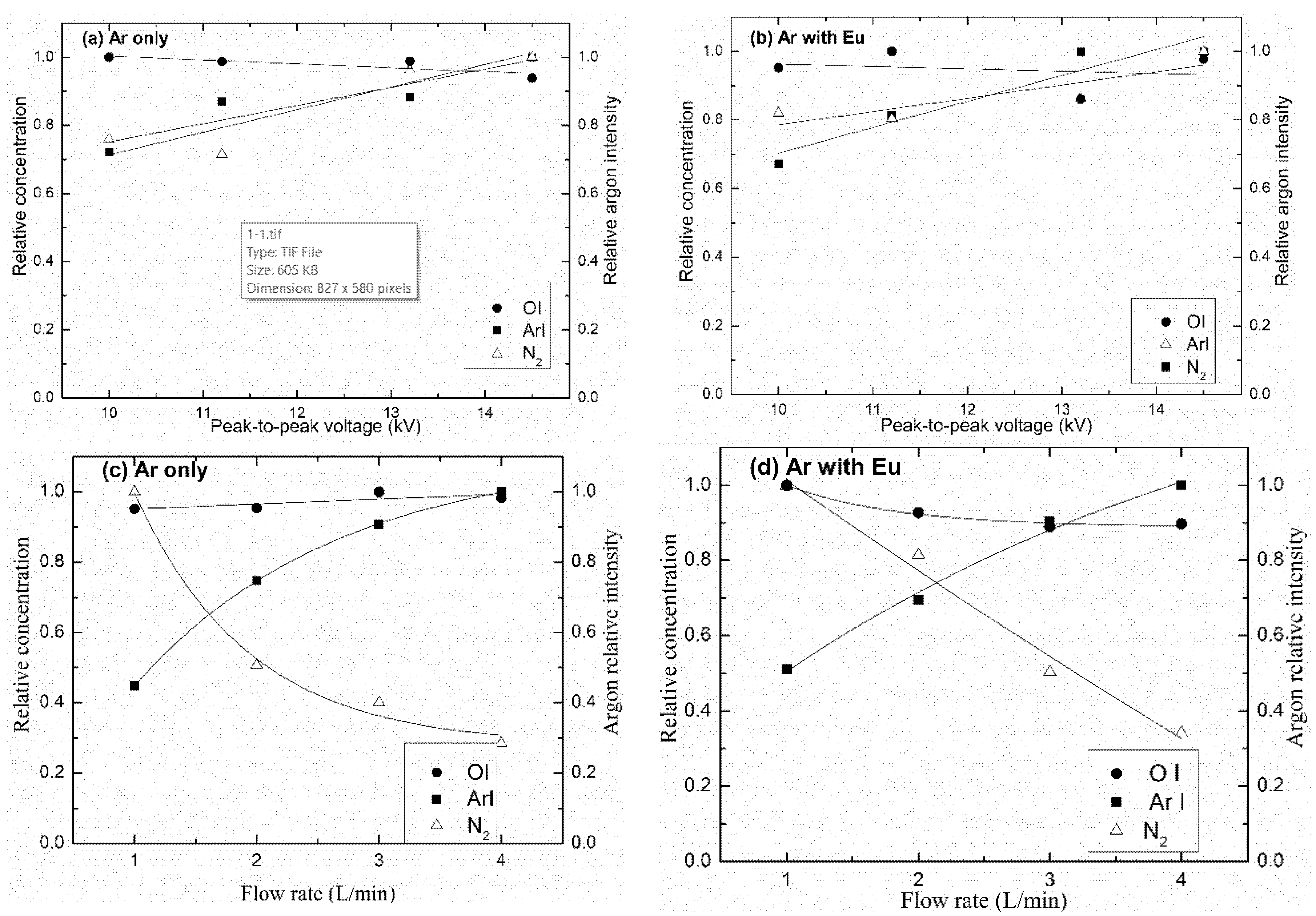

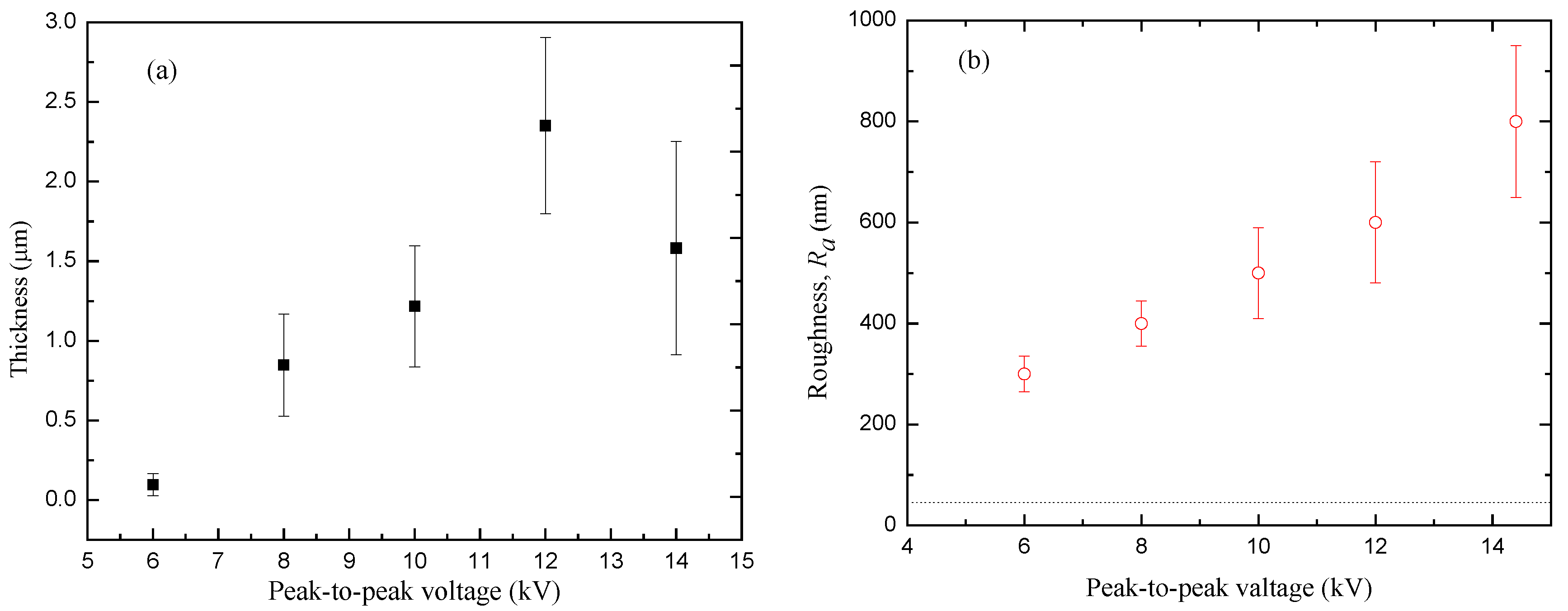

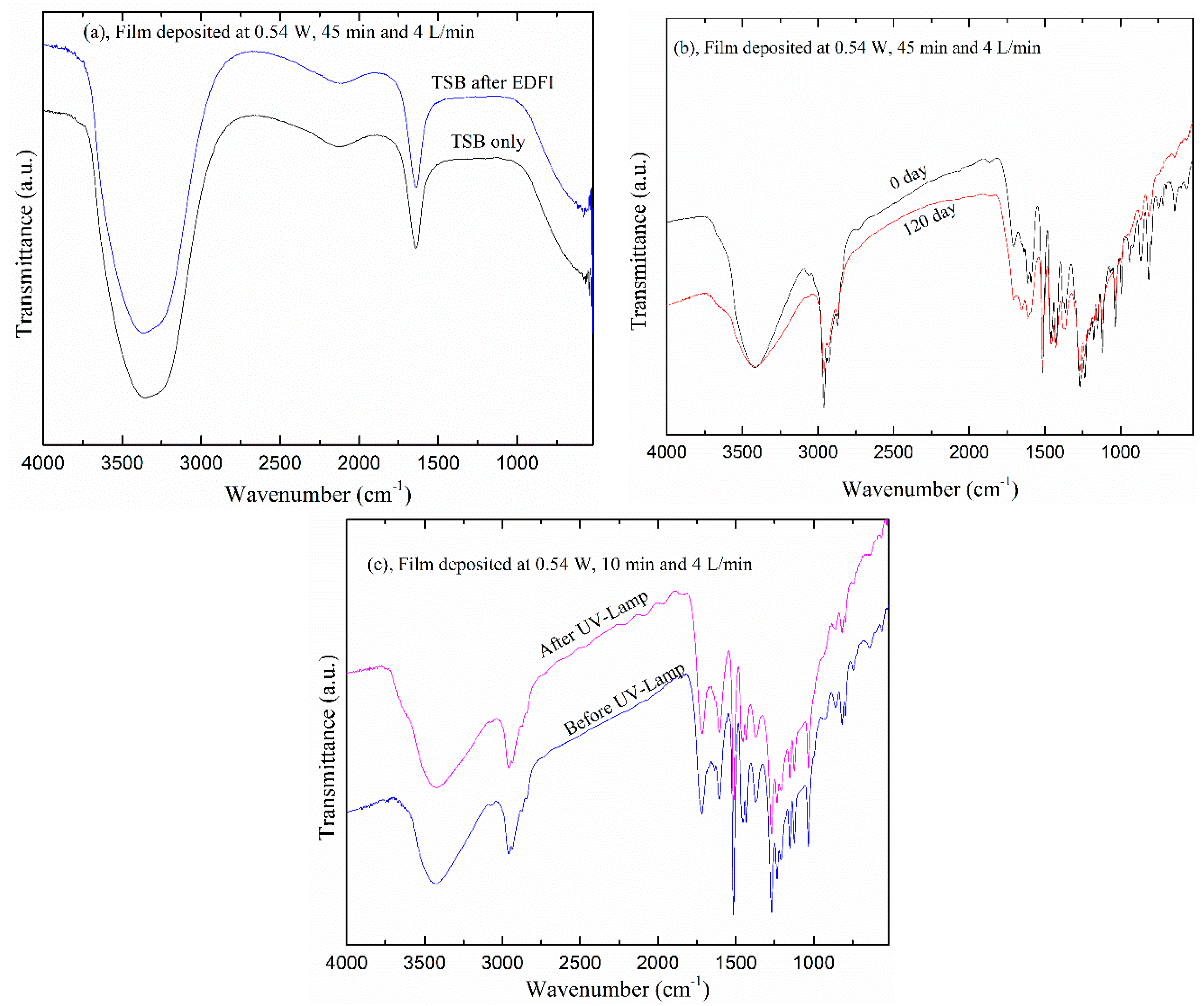
| Wavelength (nm) | Ei (eV) | Ej (eV) | Aji × 107 (s−1) | gj |
|---|---|---|---|---|
| 696.54 | 11.54 | 13.32 | 0.63 | 3 |
| 738.39 | 11.62 | 13.30 | 0.84 | 5 |
| 763.50 | 11.54 | 13.17 | 2.45 | 5 |
| 772.37 | 11.54 | 13.15 | 0.51 | 3 |
| 794.82 | 11.72 | 13.28 | 1.86 | 3 |
| 811.53 | 11.54 | 13.07 | 3.31 | 7 |
| 826.45 | 11.82 | 13.32 | 1.54 | 3 |
Publisher’s Note: MDPI stays neutral with regard to jurisdictional claims in published maps and institutional affiliations. |
© 2020 by the authors. Licensee MDPI, Basel, Switzerland. This article is an open access article distributed under the terms and conditions of the Creative Commons Attribution (CC BY) license (http://creativecommons.org/licenses/by/4.0/).
Share and Cite
Getnet, T.G.; Kayama, M.E.; Rangel, E.C.; Cruz, N.C. Thin Film Deposition by Atmospheric Pressure Dielectric Barrier Discharges Containing Eugenol: Discharge and Coating Characterizations. Polymers 2020, 12, 2692. https://doi.org/10.3390/polym12112692
Getnet TG, Kayama ME, Rangel EC, Cruz NC. Thin Film Deposition by Atmospheric Pressure Dielectric Barrier Discharges Containing Eugenol: Discharge and Coating Characterizations. Polymers. 2020; 12(11):2692. https://doi.org/10.3390/polym12112692
Chicago/Turabian StyleGetnet, Tsegaye Gashaw, Milton E. Kayama, Elidiane C. Rangel, and Nilson C. Cruz. 2020. "Thin Film Deposition by Atmospheric Pressure Dielectric Barrier Discharges Containing Eugenol: Discharge and Coating Characterizations" Polymers 12, no. 11: 2692. https://doi.org/10.3390/polym12112692
APA StyleGetnet, T. G., Kayama, M. E., Rangel, E. C., & Cruz, N. C. (2020). Thin Film Deposition by Atmospheric Pressure Dielectric Barrier Discharges Containing Eugenol: Discharge and Coating Characterizations. Polymers, 12(11), 2692. https://doi.org/10.3390/polym12112692







